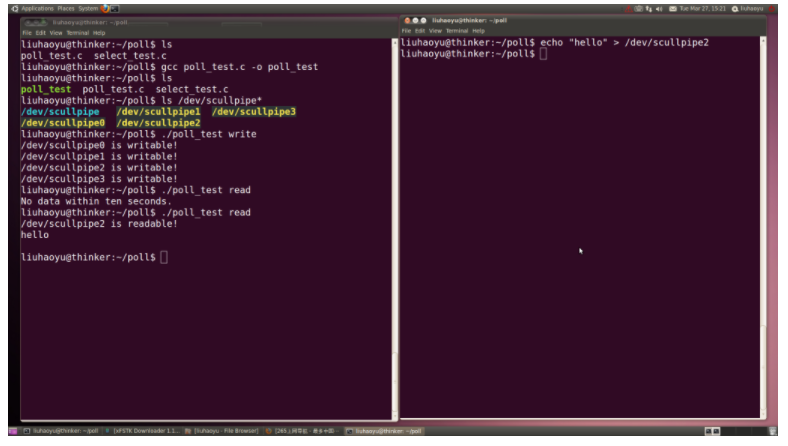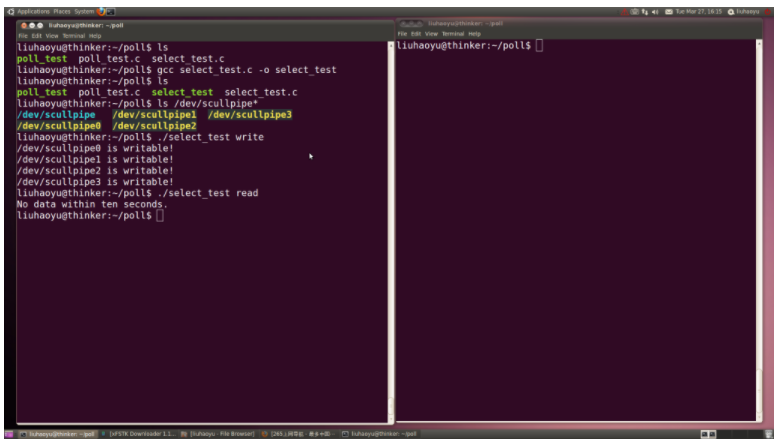LDD3源码分析之poll分析
编译环境:Ubuntu 10.10
内核版本:2.6.32-38-generic-pae
LDD3源码路径:examples/scull/pipe.c examples/scull/main.c
本文分析LDD3第6章的poll(轮询)操作。要理解驱动程序中poll函数的作用和实现,必须先理解用户空间中poll和select函数的用法。本文与前面的文章介绍的顺序有所不同,首先分析测试程序,以此理解用户空间中的poll和select函数的用法。然后再分析驱动程序怎样对用户空间的poll和select函数提供支持。
一、poll函数的使用
用户态的poll函数用以监测一组文件描述符是否可以执行指定的I/O操作,如果被监测的文件描述符都不能执行指定的I/O操作,则poll函数会阻塞,直到有文件描述符的状态发生变化,可以执行指定的I/O操作才解除阻塞。poll函数还可以指定一个最长阻塞时间,如果时间超时,将直接返回。poll函数的函数原型如下:
int poll(struct pollfd *fds, nfds_t nfds, int timeout);
要监测的文件描述符由第一个参数fds指定,它是一个struct pollfd数组,pollfd结构体定义如下:
struct pollfd {
int fd; /* file descriptor */
short events; /* requested events */
short revents; /* returned events */
};
pollfd结构体的第一个成员fd是文件描述符,代表一个打开的文件。第二个成员events是一个输入参数,用于指定poll监测哪些事件(如可读、可写等等)。第三个成员revents是一个输出参数,由内核填充,指示对于文件描述符fd,发生了哪些事件(如可读、可写等等)。
poll函数的第二个参数nfds代表监测的文件描述符的个数,即fds数组的成员个数。
poll函数的第三个参数timeout代表阻塞时间(以毫秒为单位),如果poll要求监测的事件没有发生,则poll会阻塞最多timeout毫秒。如果timeout设置为负数,则poll会一直阻塞,直到监测的事件发生。
poll函数如果返回一个正数,代表内核返回了状态(保存在pollfd.revents中)的文件描述符的个数。如果poll返回0,表明是因为超时而返回的。如果poll返回-1,表明poll调用出错。
poll函数可以监测哪些状态(由pollfd.events指定),以及内核可以返回哪些状态(保存在pollfd.revents中),由下面的宏设定:
POLLIN:There is data to read. POLLOUT:Writing now will not block. POLLPRI:There is urgent data to read (e.g., out-of-band data on TCP socket; pseudo-terminal master in packet mode has seen state change in slave). POLLRDHUP: (since Linux 2.6.) Stream socket peer closed connection, or shut down writing half of connection. The _GNU_SOURCE feature test macro must be defined in order to obtain this definition. POLLERR:Error condition (output only). POLLHUP:Hang up (output only). POLLNVAL:Invalid request: fd not open (output only). When compiling with _XOPEN_SOURCE defined, one also has the following, which convey no further information beyond the bits listed above: POLLRDNORM:Equivalent to POLLIN. POLLRDBAND:Priority band data can be read (generally unused on Linux). POLLWRNORM:Equivalent to POLLOUT. POLLWRBAND:Priority data may be written.
下面我们看一个测试scullpipe设备的poll操作(内核态poll)的测试程序,该程序使用了我们前面介绍的poll函数(用户态poll)。其代码如下:
#include <stdio.h>
#include <stdlib.h>
#include <string.h>
#include <fcntl.h>
#include <unistd.h>
#include <linux/poll.h>
#include <sys/time.h>
#include <sys/types.h>
#include <sys/stat.h> int main(int argc, char *argv[])
{
int fd0, fd1, fd2, fd3;
struct pollfd poll_fd[];
char buf[];
int retval; if(argc != || ((strcmp(argv[], "read") != ) && (strcmp(argv[], "write") != )))
{
printf("usage: ./poll_test read|write\n");
return -;
} fd0 = open("/dev/scullpipe0", O_RDWR);
if ( fd0 < )
{
printf("open scullpipe0 error\n");
return -;
} fd1 = open("/dev/scullpipe1", O_RDWR);
if ( fd1 < )
{
printf("open scullpipe1 error\n");
return -;
} fd2 = open("/dev/scullpipe2", O_RDWR);
if ( fd2 < )
{
printf("open scullpipe2 error\n");
return -;
} fd3 = open("/dev/scullpipe3", O_RDWR);
if ( fd3 < )
{
printf("open scullpipe3 error\n");
return -;
} if(strcmp(argv[], "read") == )
{
poll_fd[].fd = fd0;
poll_fd[].fd = fd1;
poll_fd[].fd = fd2;
poll_fd[].fd = fd3; poll_fd[].events = POLLIN | POLLRDNORM;
poll_fd[].events = POLLIN | POLLRDNORM;
poll_fd[].events = POLLIN | POLLRDNORM;
poll_fd[].events = POLLIN | POLLRDNORM; retval = poll(poll_fd, , );
}
else
{
poll_fd[].fd = fd0;
poll_fd[].fd = fd1;
poll_fd[].fd = fd2;
poll_fd[].fd = fd3; poll_fd[].events = POLLOUT | POLLWRNORM;
poll_fd[].events = POLLOUT | POLLWRNORM;
poll_fd[].events = POLLOUT | POLLWRNORM;
poll_fd[].events = POLLOUT | POLLWRNORM; retval = poll(poll_fd, , );
} if (retval == -)
{
printf("poll error!\n");
return -;
}
else if (retval)
{
if(strcmp(argv[], "read") == )
{
if(poll_fd[].revents & (POLLIN | POLLRDNORM))
{
printf("/dev/scullpipe0 is readable!\n");
memset(buf, , );
read(fd0, buf, );
printf("%s\n", buf);
} if(poll_fd[].revents & (POLLIN | POLLRDNORM))
{
printf("/dev/scullpipe1 is readable!\n");
memset(buf, , );
read(fd1, buf, );
printf("%s\n", buf);
} if(poll_fd[].revents & (POLLIN | POLLRDNORM))
{
printf("/dev/scullpipe2 is readable!\n");
memset(buf, , );
read(fd2, buf, );
printf("%s\n", buf);
} if(poll_fd[].revents & (POLLIN | POLLRDNORM))
{
printf("/dev/scullpipe3 is readable!\n");
memset(buf, , );
read(fd3, buf, );
printf("%s\n", buf);
}
}
else
{
if(poll_fd[].revents & (POLLOUT | POLLWRNORM))
{
printf("/dev/scullpipe0 is writable!\n");
} if(poll_fd[].revents & (POLLOUT | POLLWRNORM))
{
printf("/dev/scullpipe1 is writable!\n");
} if(poll_fd[].revents & (POLLOUT | POLLWRNORM))
{
printf("/dev/scullpipe2 is writable!\n");
} if(poll_fd[].revents & (POLLOUT | POLLWRNORM))
{
printf("/dev/scullpipe3 is writable!\n");
}
}
}
else
{
if(strcmp(argv[], "read") == )
{
printf("No data within ten seconds.\n");
}
else
{
printf("Can not write within ten seconds.\n");
}
} return ;
}
测试过程如下图所示:

从上图可以看出,scullpipe0 - scullpipe3都是可写的。但是因为没有向其中写入任何内容,所以读的时候会阻塞住,因为测试程序设置最长阻塞时间为10秒,所以10秒后解除阻塞退出,并打印”No data within ten seconds.”。
下面再次测试读操作,因为设备中没有内容,还是阻塞住,但是在10秒钟内,从另外一个终端向/dev/scullpipe2写入数据,这里是写入字符串”hello”,可以看到,写入数据后,测试程序解除阻塞,并打印”/dev/scullpipe2 is readable!”和”hello”字符串,这个过程如下图所示:

二、select函数的使用
select函数的作用与poll函数类似,也是监测一组文件描述符是否准备好执行指定的I/O操作。如果没有任何一个文件描述符可以完成指定的操作,select函数会阻塞住。select函数可以指定一个最长阻塞时间,如果超时,则直接返回。
select函数的函数原型如下:
int select(int nfds, fd_set *readfds, fd_set *writefds,
fd_set *exceptfds, struct timeval *timeout);
select通过三个独立的文件描述符集(fd_set)readfds,writefds,exceptfds指示监测哪些文件描述符,其中readfds中的文件描述符监测是否可进行非阻塞的读操作。writefds数组中的文件描述符监测是否可进行非阻塞的写操作。exceptfds数组中的文件描述符监测是否有异常(exceptions)。
select的第一个参数nfds是三个文件描述符集readfds、writefds、exceptfds中最大文件描述符值加1。
select的最后一个参数timeout代表最长阻塞时间。
select函数返回满足指定I/O要求的文件描述符的个数,如果是超时退出的,select函数返回0。如果出错,select函数返回-1。
有四个宏用来操作文件描述符集:
void FD_ZERO(fd_set *set); 清空一个文件描述符集。 void FD_SET(int fd, fd_set *set); 将一个文件描述符fd加入到指定的文件描述符集set中。 void FD_CLR(int fd, fd_set *set); 将一个文件描述符fd从指定的文件描述符集set中删除。 int FD_ISSET(int fd, fd_set *set); 测试文件描述符fd是否在指定的文件描述符集set中。
下面我们看使用select函数实现的测试驱动中poll操作的测试程序,其代码如下:
#include <stdio.h>
#include <stdlib.h>
#include <string.h>
#include <fcntl.h>
#include <unistd.h>
#include <sys/time.h>
#include <sys/types.h>
#include <sys/stat.h> int main(int argc, char *argv[])
{
fd_set rfds, wfds;
int fd0, fd1, fd2, fd3;
char buf[];
int retval; /* Wait up to ten seconds. */
struct timeval tv;
tv.tv_sec = ;
tv.tv_usec = ; if(argc != || ((strcmp(argv[], "read") != ) && (strcmp(argv[], "write") != )))
{
printf("usage: ./select_test read|write\n");
return -;
} fd0 = open("/dev/scullpipe0", O_RDWR);
if ( fd0 < )
{
printf("open scullpipe0 error\n");
return -;
} fd1 = open("/dev/scullpipe1", O_RDWR);
if ( fd1 < )
{
printf("open scullpipe1 error\n");
return -;
} fd2 = open("/dev/scullpipe2", O_RDWR);
if ( fd2 < )
{
printf("open scullpipe2 error\n");
return -;
} fd3 = open("/dev/scullpipe3", O_RDWR);
if ( fd3 < )
{
printf("open scullpipe3 error\n");
return -;
} if(strcmp(argv[], "read") == )
{
FD_ZERO(&rfds);
FD_SET(fd0, &rfds);
FD_SET(fd1, &rfds);
FD_SET(fd2, &rfds);
FD_SET(fd3, &rfds);
retval = select(fd3 + , &rfds, NULL, NULL, &tv);
}
else
{
FD_ZERO(&wfds);
FD_SET(fd0, &wfds);
FD_SET(fd1, &wfds);
FD_SET(fd2, &wfds);
FD_SET(fd3, &wfds);
retval = select(fd3 + , NULL, &wfds, NULL, &tv);
} if (retval == -)
{
printf("select error!\n");
return -;
}
else if (retval)
{
if(strcmp(argv[], "read") == )
{
if(FD_ISSET(fd0, &rfds))
{
printf("/dev/scullpipe0 is readable!\n");
memset(buf, , );
read(fd0, buf, );
printf("%s\n", buf);
} if(FD_ISSET(fd1, &rfds))
{
printf("/dev/scullpipe1 is readable!\n");
memset(buf, , );
read(fd1, buf, );
printf("%s\n", buf);
} if(FD_ISSET(fd2, &rfds))
{
printf("/dev/scullpipe2 is readable!\n");
memset(buf, , );
read(fd2, buf, );
printf("%s\n", buf);
} if(FD_ISSET(fd3, &rfds))
{
printf("/dev/scullpipe3 is readable!\n");
memset(buf, , );
read(fd3, buf, );
printf("%s\n", buf);
}
}
else
{
if(FD_ISSET(fd0, &wfds))
{
printf("/dev/scullpipe0 is writable!\n");
} if(FD_ISSET(fd1, &wfds))
{
printf("/dev/scullpipe1 is writable!\n");
} if(FD_ISSET(fd2, &wfds))
{
printf("/dev/scullpipe2 is writable!\n");
} if(FD_ISSET(fd3, &wfds))
{
printf("/dev/scullpipe3 is writable!\n");
}
}
}
else
{
if(strcmp(argv[], "read") == )
{
printf("No data within ten seconds.\n");
}
else
{
printf("Can not write within ten seconds.\n");
}
} return ;
}
测试过程如下图所示:

从上图可以看出,scullpipe0 - scullpipe3都是可写的。但是因为没有向其中写入任何内容,所以读的时候会阻塞住,因为测试程序设置最长阻塞时间为10秒,所以10秒后解除阻塞退出,并打印”No data within ten seconds.”。
下面再次测试读操作,因为设备中没有内容,还是阻塞住,但是在10秒钟内,从另外一个终端向/dev/scullpipe2写入数据,这里是写入字符串”hello”,可以看到,写入数据后,测试程序解除阻塞,并打印”/dev/scullpipe2 is readable!”和”hello”字符串,这个过程如下图所示:

三、驱动程序中poll操作的实现
用户空间的poll和select函数,最终都会调用驱动程序中的poll函数,其函数原型如下:
unsigned int (*poll) (struct file *filp, poll_table *wait);
poll函数应该实现两个功能:
一是把能标志轮询状态变化的等待队列加入到poll_table中,这通过调用poll_wait函数实现。
二是返回指示能进行的I/O操作的标志位。
poll函数的第二个参数poll_table,是内核中用来实现poll,select系统调用的结构体,对于驱动开发者来说,不必关心其具体内容,可以把poll_table看成是不透明的结构体,只要拿过来使用就可以了。驱动程序通过poll_wait函数,把能够唤醒进程,改变轮询状态的等待队列加入到poll_table中。该函数定义如下:
void poll_wait (struct file *, wait_queue_head_t *, poll_table *);
对于poll函数的第二个功能,返回的标志位与用户空间相对应,最常用的标志位是POLLIN | POLLRDNORM和POLLOUT | POLLWRNORM,分别标志可进行非阻塞的读和写操作。
下面看scullpipe设备对poll操作的实现,其内容其实非常简单:
228static unsigned int scull_p_poll(struct file *filp, poll_table *wait)
{
struct scull_pipe *dev = filp->private_data;
unsigned int mask = ; /*
234 * The buffer is circular; it is considered full
235 * if "wp" is right behind "rp" and empty if the
236 * two are equal.
237 */
down(&dev->sem);
poll_wait(filp, &dev->inq, wait);
poll_wait(filp, &dev->outq, wait);
if (dev->rp != dev->wp)
mask |= POLLIN | POLLRDNORM; /* readable */
if (spacefree(dev))
mask |= POLLOUT | POLLWRNORM; /* writable */
up(&dev->sem);
return mask;
}
第239行,调用poll_wait函数将读等待队列加入到poll_table中。
第240行,调用poll_wait函数将写等待队列加入到poll_table中。
241 - 242行,如果有内容可读,设置可读标志位。
243 - 244行,如果有空间可写,设置可写标志位。
246行,将标志位返回。
驱动程序中的poll函数很简单,那么内核是怎么实现poll和select系统调用的呢?当用户空间程序调用poll和select函数时,内核会调用由用户程序指定的全部文件的poll方法,并向它们传递同一个poll_table结构。poll_table结构其实是一个生成”实际数据结构”的函数(名为poll_queue_proc)的封装,这个函数poll_queue_proc,不同的应用场景,内核有不同的实现,这里我们不仔细研究对应的函数。对于poll和select系统调用来说,这个”实际数据结构”是一个包含poll_table_entry结构的内存页链表。这里提到的相关数据结构在linux-2.6.32-38源码中,定义在include/linux/poll.h文件中,代码如下所示:
/*
31 * structures and helpers for f_op->poll implementations
32 */
33typedef void (*poll_queue_proc)(struct file *, wait_queue_head_t *, struct poll_table_struct *); 35typedef struct poll_table_struct {
poll_queue_proc qproc;
unsigned long key;
} poll_table;
static inline void poll_wait(struct file * filp, wait_queue_head_t * wait_address, poll_table *p)
{
if (p && wait_address)
p->qproc(filp, wait_address, p);
}
static inline void init_poll_funcptr(poll_table *pt, poll_queue_proc qproc)
{
pt->qproc = qproc;
pt->key = ~0UL; /* all events enabled */
}
struct poll_table_entry {
struct file *filp;
unsigned long key;
wait_queue_t wait;
wait_queue_head_t *wait_address;
};
poll操作我们就分析完了,内核要求驱动程序做的事并不多,但是我们在学习时,要把poll操作和前面介绍的阻塞型read/write函数以及scullpipe设备的等待队列等结合起来考虑,因为scullpipe设备是一个完整的程序模块。
LDD3源码分析之poll分析的更多相关文章
- ArrayList源码和多线程安全问题分析
1.ArrayList源码和多线程安全问题分析 在分析ArrayList线程安全问题之前,我们线对此类的源码进行分析,找出可能出现线程安全问题的地方,然后代码进行验证和分析. 1.1 数据结构 Arr ...
- Okhttp3源码解析(3)-Call分析(整体流程)
### 前言 前面我们讲了 [Okhttp的基本用法](https://www.jianshu.com/p/8e404d9c160f) [Okhttp3源码解析(1)-OkHttpClient分析]( ...
- Okhttp3源码解析(2)-Request分析
### 前言 前面我们讲了 [Okhttp的基本用法](https://www.jianshu.com/p/8e404d9c160f) [Okhttp3源码解析(1)-OkHttpClient分析]( ...
- Spring mvc之源码 handlerMapping和handlerAdapter分析
Spring mvc之源码 handlerMapping和handlerAdapter分析 本篇并不是具体分析Spring mvc,所以好多细节都是一笔带过,主要是带大家梳理一下整个Spring mv ...
- HashMap的源码学习以及性能分析
HashMap的源码学习以及性能分析 一).Map接口的实现类 HashTable.HashMap.LinkedHashMap.TreeMap 二).HashMap和HashTable的区别 1).H ...
- ThreadLocal源码及相关问题分析
前言 在高并发的环境下,当我们使用一个公共的变量时如果不加锁会出现并发问题,例如SimpleDateFormat,但是加锁的话会影响性能,对于这种情况我们可以使用ThreadLocal.ThreadL ...
- 物联网防火墙himqtt源码之MQTT协议分析
物联网防火墙himqtt源码之MQTT协议分析 himqtt是首款完整源码的高性能MQTT物联网防火墙 - MQTT Application FireWall,C语言编写,采用epoll模式支持数十万 ...
- Netty 源码学习——客户端流程分析
Netty 源码学习--客户端流程分析 友情提醒: 需要观看者具备一些 NIO 的知识,否则看起来有的地方可能会不明白. 使用版本依赖 <dependency> <groupId&g ...
- linux源码Makefile的详细分析
目录 一.概述 1.本文的意义 2.Linux内核Makefile文件组成 二.Linux内核Makefile的“make解析”过程 1 顶层Makefile阶段 1.从总目标uImage说起 2.v ...
随机推荐
- mysql配置临时日志(无需重启服务)
use mysql; //指定日志的存储方式 SET GLOBAL log_output = 'TABLE'; //查询日志开启 SET GLOBAL general_log = 'ON'; sele ...
- Navicat导出数据库设计文档
前言:仅支持单表导出 导出sql: SELECT TABLE_NAME 表名, COLUMN_NAME 列名, COLUMN_TYPE 数据类型, COLUMN_KEY 主键, IF(IS_NULLA ...
- nginx-1.12.0安装
1.配置相关环境: yum install -y gcc glibc gcc-c++ zlib pcre-devel openssl-devel rewrite模块需要pcre库 ssl功能需要ope ...
- Hive性能优化【严格模式、join优化、Map-Side聚合、JVM重用】
一.严格模式 通过设置以下参数开启严格模式: >set hive.mapred.mode=strict;[默认为nonstrict非严格模式] 查询限制: 1.对于分区表,必须添加where查询 ...
- RSA加密&解密【Java&Scala】
一.简介 RSA加密算法是一种非对称加密算法.在公开密钥加密和电子商业中RSA被广泛使用. RSA公开密钥密码体制.所谓公开密钥密码体制就是使用不同的加密密钥与解密密钥,是一种“由已知加密密钥推导出解 ...
- httpclient工具类,post请求发送json字符串参数,中文乱码处理
在使用httpclient发送post请求的时候,接收端中文乱码问题解决. 正文: 我们都知道,一般情况下使用post请求是不会出现中文乱码的.可是在使用httpclient发送post请求报文含中文 ...
- django模板和静态文件
1.为什么要使用模板 在上一篇博文中,提到了HttpReponse,但是HttpReponse只能传送字符串,如果要构建一个网页,那么工作量就会十分巨大.模板是一种方便的标签,存在于HTML文件中,我 ...
- FreeBSD安装后使用su命令显示sorry的解决办法
FreeBSD中,可以使用su命令成为root用户,但FreeBSD对执行su命令的用户进行了更严格的限制,能使用su命令的用户必须属于wheel组(root的基本属组,组ID为0),否则就不能通过 ...
- Python并发编程-GIL全局解释器锁
Python并发编程-GIL全局解释器锁 作者:尹正杰 版权声明:原创作品,谢绝转载!否则将追究法律责任. 一.GIL全局解释器锁概述 CPython 在解释器进程级别有一把锁,叫做GIL,即全局解释 ...
- Python+Appium学习之启动手机APP或者浏览器
一.启动浏览器:pycharm中python脚本如下: from appium import webdriver desired_caps ={ 'platformName':'Android', ' ...
